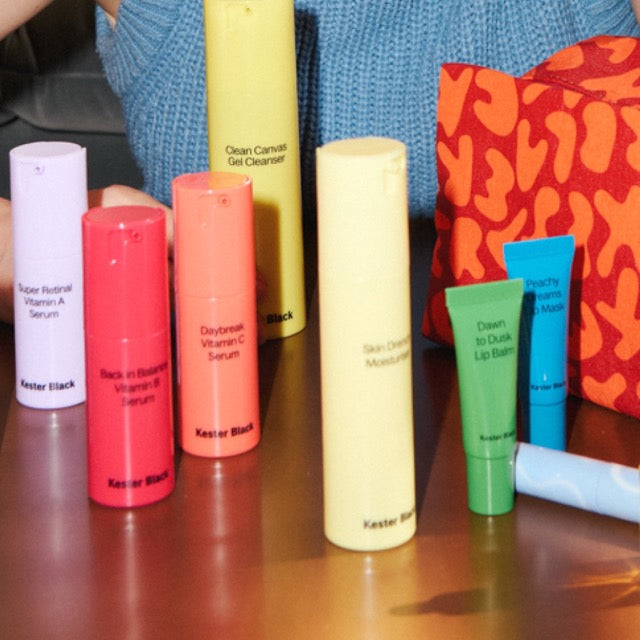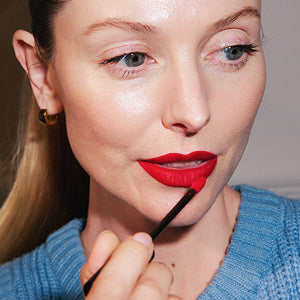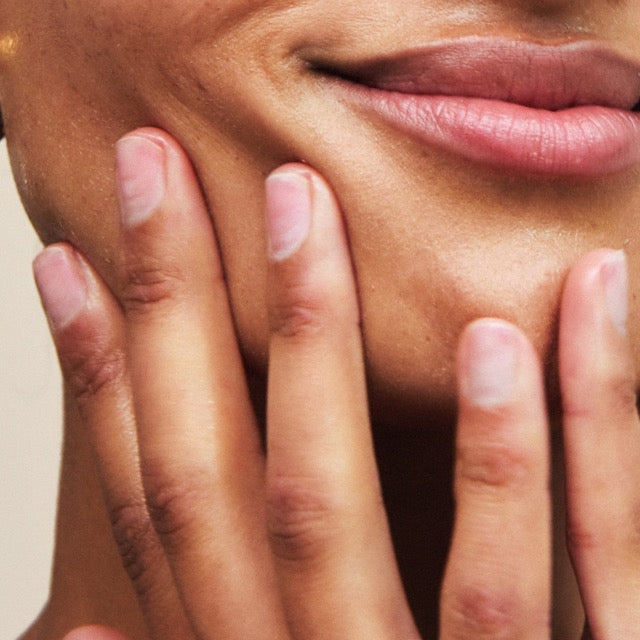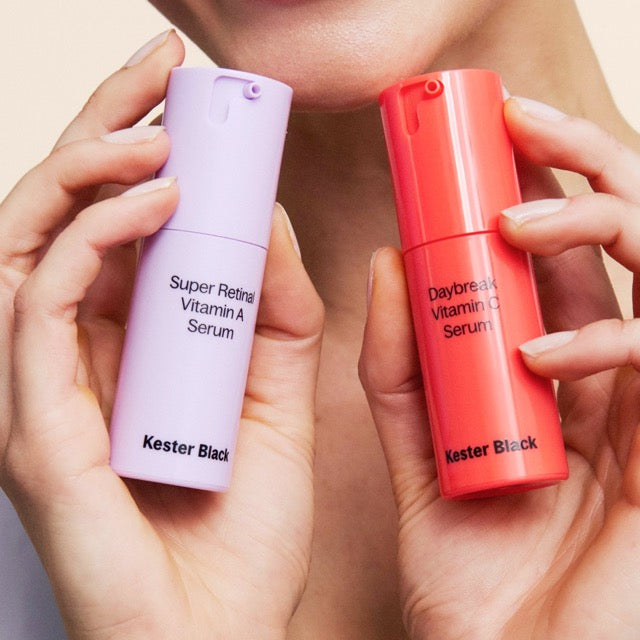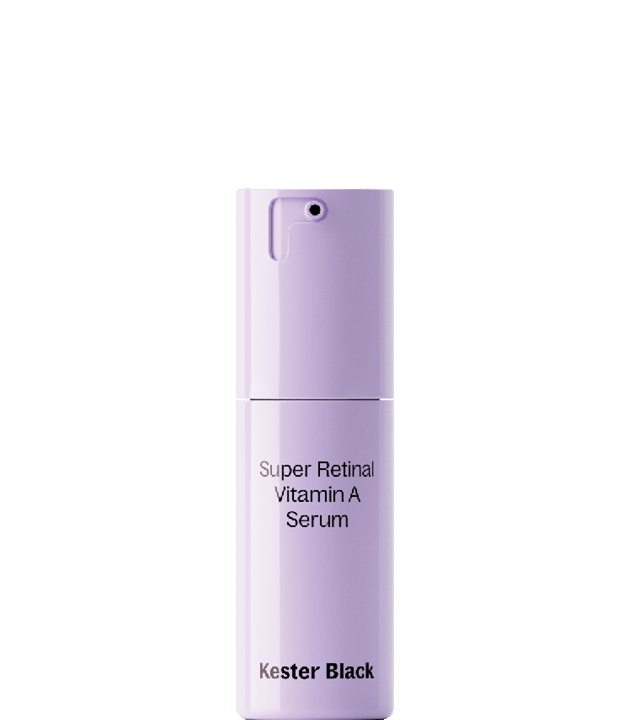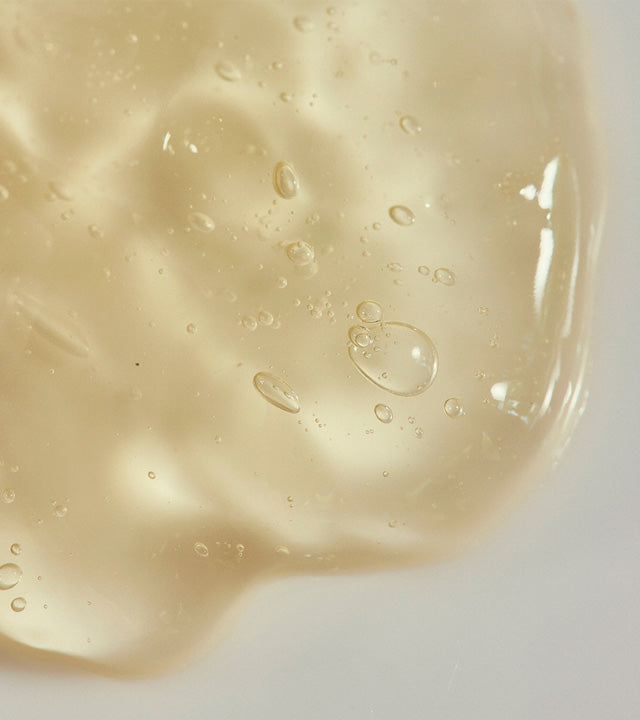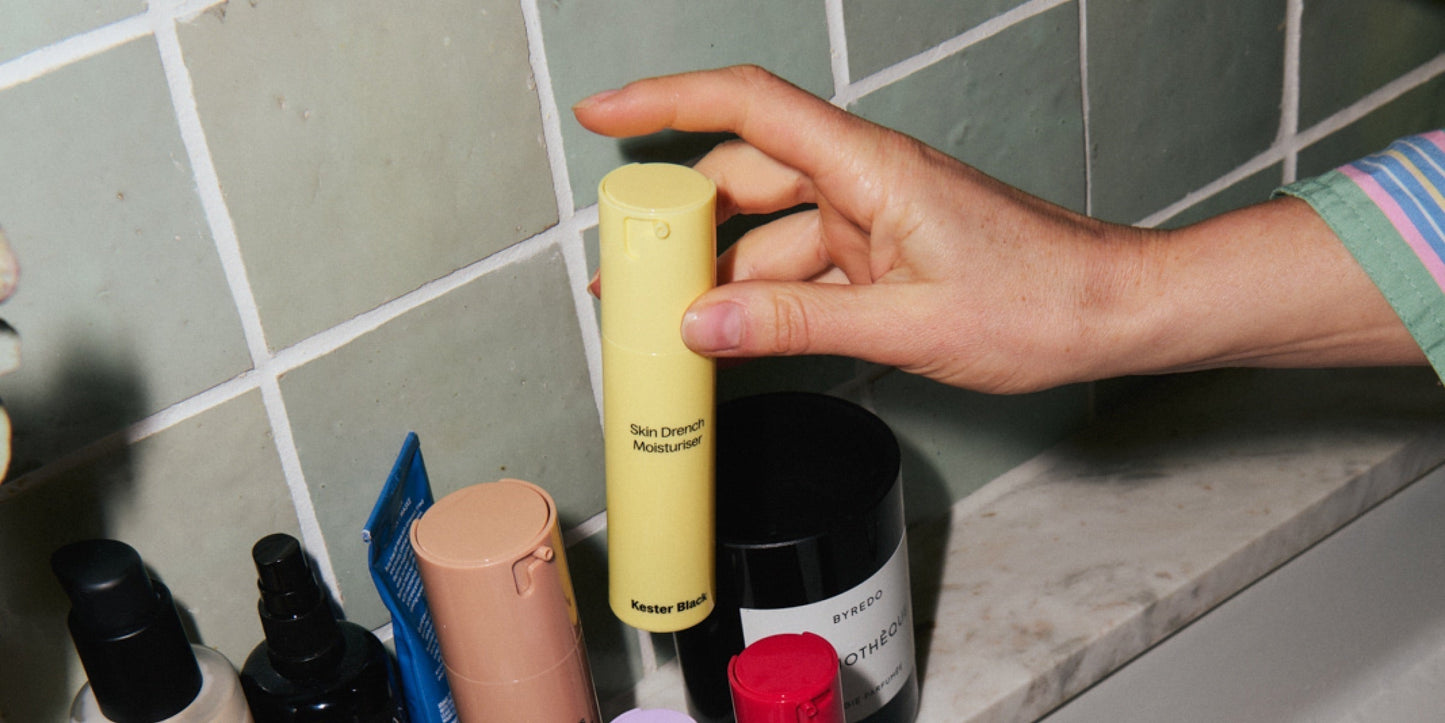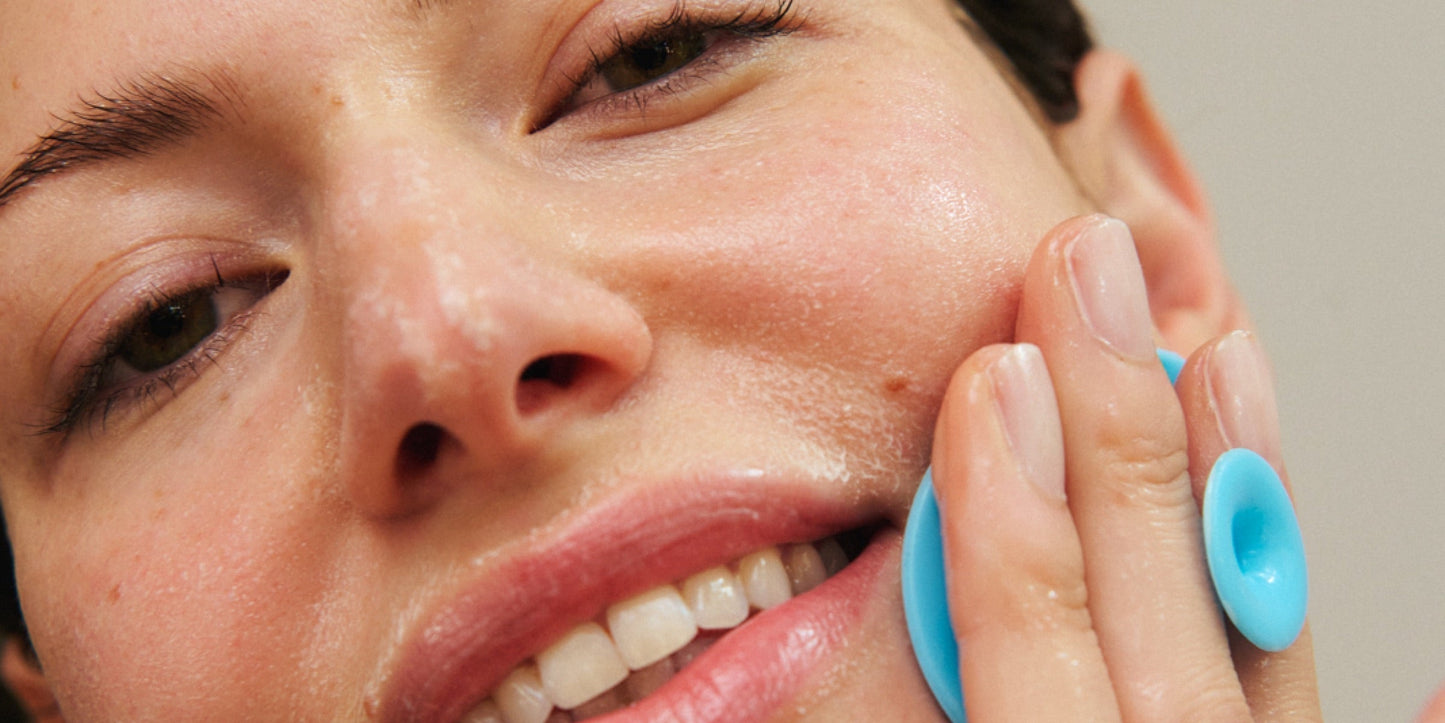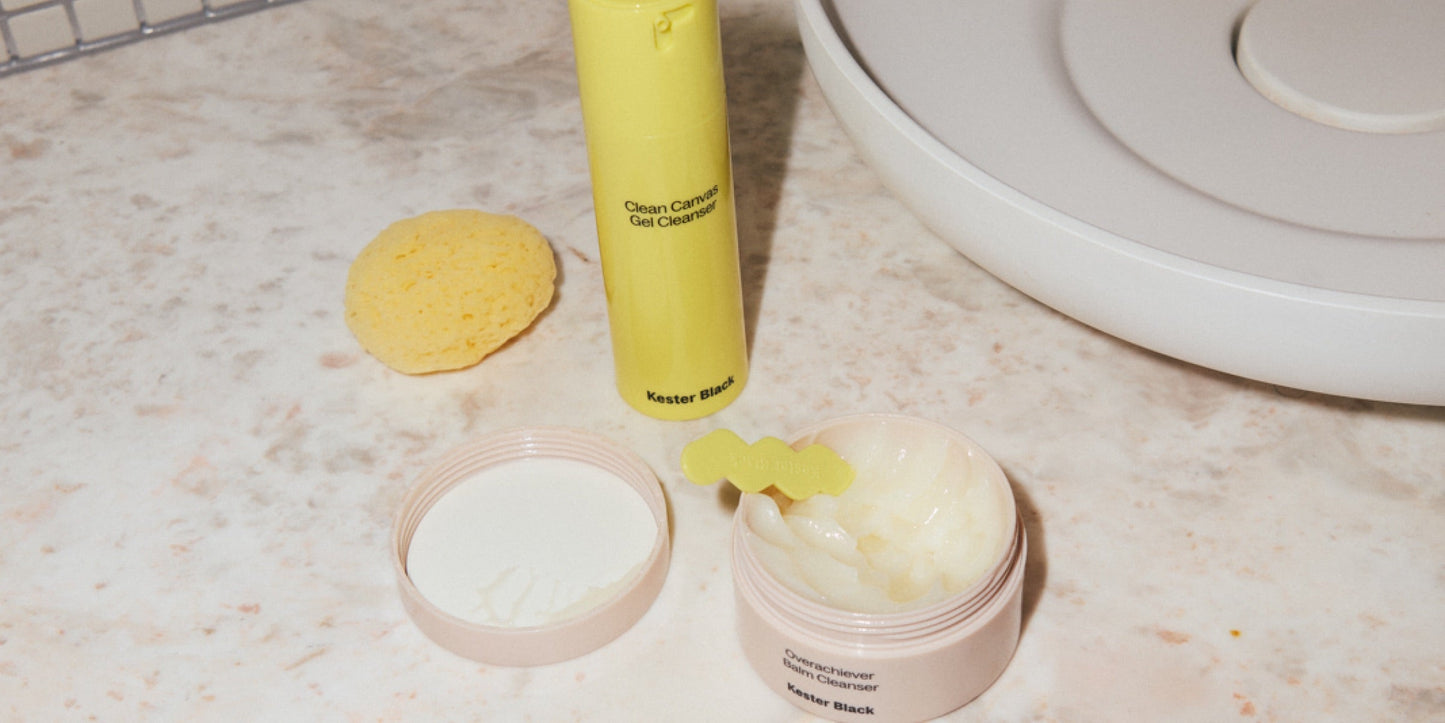The best at-home anti-ageing skincare routine
20 February 2024 – 21 min read
Admit it. You’ve dabbled in an e-tail spree or two involving new facial scrubs, moisturisers and sunscreen. But how many of these new purchases actually serve our skin, and what do we really know about the products on our shelves? We know that not all products are made equal, and while TikTok may be great at pedalling affordable chemist alternatives to tackle teenage breakouts, it’s a whole different ball game when it comes to creating a simple, effective anti-ageing skincare routine.
When you were younger you could put anything on your skin (body gel with glitter, fluro eyeshadows from the $2 Shop, questionable tanning sprays) and your skin would bounce back, resilient as anything. Better than that, it responded to skincare much more readily. But for those of us over 30, the cells in your skin become more easily damaged due to environmental and atmospheric pollution and UV. You can no longer get away with using the same cheap, quick-fix, cure-all products that you used to. If you’re not using active ingredients, in the right concentrations and molecular weights, you’re likely wasting your time and money. And so the search for a high-performance, scientifically-proven anti-ageing skincare routine begins. (Enter Kester Black skincare, functional formulas designed to create an immersive, indulgent experience, but more on that below).
Routines: From the non-existent to never ending
Our skin is our body’s largest organ, and so it makes sense that we’re fixated on pampering, nourishing and protecting it. It endures all kinds of conditions, from fluctuations in humidity to growth - don’t even get us started on the foods we eat. So it should come as no surprise that no singular routine will work for all skin types. This explains why your 12-step K-Beauty system mighn’t work for your partner; who insists soap and water will suffice (sorcery).
To sort the need from the needless, we asked dermatologist and cosmetic chemist Megan Dempsey of Megan Dempsey THE CLINIC, about what we should know about our skin, what it likes, dislikes, and how to protect it for years to come.
Your AM skincare routine
Your skincare routine should set you up for success every single day, working in order from the thinnest, lightest product to the thickest and heaviest - but always starting with a cleanser.
Morning step 1: cleanser
But what could you possibly have to clean off of your face if you’ve been sleeping, you ask? Just like cleansing your nails before painting, cleansing your skin before beginning your skincare routine ensures your products will work properly. Appling expensive skincare to an unprepped face is as good as throwing money down the drain. Our skin expert Megan recommends cream, oil or balm cleansers like our Overachiever Balm Cleanser as they won’t strip your skin of its natural oils. If your skin is dry (a skin type not a skin condition), ageing or sensitive, oil and balm cleansers are brilliant in making up for the oils your skin struggles to produce. If your skin is dehydrated (a condition that can be remedied and isn’t affected so much by your genetics) or oily, then oil and balm cleansers are great for gently removing makeup and excess residue without stripping your skin of moisture.
A good oil or balm cleanser starts solid on dry skin, then turns milky and washes off with lukewarm water - it shouldn’t leave behind any greasy residue. Always use tepid water during the cleansing process. If you’re applying your cleanser in shower, please resist the urge to steam your face off by facing away from the showerhead. Trust us on this one, it’ll prevent intense heat and pressure from potentially bursting precious blood vessels under the skin - and the telltale broken capillaries they come with.
Do:
- Cleanse before applying any further skincare.
- Dabble in oil or balm cleansers.
- Use lukewarm water while cleansing.
- Cleanse for at least 60 seconds before rinsing off.
- Properly wash your hands before placing them anywhere near your face.
Don’t:
- Skip this step.
- Use foaming cleansers that contain SLS or SLES. The addition of these surfactants make things foamy (like your detergent and shampoo), but can also strip the skin and mess with its pH. Not only does this cause irritation, it can prompt the skin to compensate by producing more oil.
- Rinse your face directly under the showerhead. The skin on your face and decolletage is super delicate.
Fun fact:
Your skin's natural protective layer, called the acid mantle, acts as a lipid barrier to guard your skin from baddies (acid, toxins, bacteria, infection). Think of it as the good fat that you actually want hanging around. Thanks to this layer, your skin's pH sits on the acidic side (roughly 5.5) and the addition of something like SLS or SLES which is more basic (on the alkaline side of the pH scale) might upset the balance. Adding more alkaline products to your skin may make it feel squeaky clean, but it could actually be messing with its pH; compromising your acid mantle.
Morning step 2: serum/s
Back it up with vitamin B
B as in brightening, balancing, and blooming brilliant. B Vitamins are naturally occurring, skin-loving compounds and they exist in a bunch of fruits and veggies (vegans everywhere, rejoice!). Our dermatologist Megan, thinks everyone should incorporate Vitamin B into their morning skin routine, as it helps to strengthen cell walls and increase your skin’s ability to hold moisture; making it plumpier, less wrinkly and all-round healthier. It also helps to balance the skin’s natural oil production and suits all skin types - say goodbye to greasy and he-llo to a more dewy luminous complexion. Enter our Back In Balance Vitamin B Serum, a quick-absorbing formula to soothe and hydrate when skin needs a reset. We love this ingredient so much that we’ve used it in our Rest & Repair Mask for its inherent healing qualities.
A collection of clinical papers (including this one) have proven that niacinamide (or vitamin B3) not only penetrates the stratum corneum (the skin’s barrier to transepidermal water-loss), it supports skin cell renewal by improving its ability to retain moisture.
Do:
- Use this product if you’re keen to repair your skin’s lipid barrier.
- Use vitamin B if your skin is dehydrated.
- Make sure it’s in an airtight, opaque pack.
- Wait at least ten minutes before applying vitamin C, as antioxidants can diminish one another when used in tandem.
Don’t:
- Use niacinamide every day if you’re just starting out. Start once a week and work up a tolerance.
- Exceed 5% concentration to start with.
Why ageing skin loves vitamin C
C is for collagen. Vitamin C (ascorbic acid or l-ascorbic acid) doesn’t just love your insides, this antioxidant stimulates your skin’s natural ability to produce collagen; a key structural protein that makes skin strong and elastic. (Bonus: increased collagen production turns skin cells over more quickly, which helps to push pigmentation to the surface of the skin to eventually flake off and be removed, as well as making skin appear more radiant. Thus vitamin C’s glowing reputation for brightening and evening out skin). But when exposed to UV, free radicals can damage our skin by breaking down collagen (the worst). Good thing vitamin C is a natural photo protectant, which means it guards your skin from any oxidative stress and free radicals caused by UV exposure. Take that, sunshine! Our dermatologist Megan recommends using vitamin C like Daybreak Vitamin C Serum during your AM routine to make the most of its protective and strengthening qualities when you’re most likely to be exposed. To complement this protection, we highly recommend wearing sunscreen every day (but more on that later).
And before you go rubbing orange slices on your face, know that there’s a whole range of dedicated topical solutions available for you to try. Like many acids, vitamin C is rather unstable on its own, readily oxidising in the presence of water. So you’ll often notice it combined with a blend of other compounds like vitamin E for stability and prolonged effectiveness, as in the case of Daybreak Vitamin C Serum. Look for ‘ascorbic acid’ or ‘ascorbate’ compounds in the ingredients list. For this reason, we recommend products that aren’t openly exposed to air (screw-top tubs, pots, dropper bottles) as this could prematurely degrade their effectiveness.
Do:
- Use vitamin C early in the day, before sun exposure, paired with a good SPF product.
- Seek out a serum with 15% vitamin C active such as ascorbic acid.
- Seek products in light-proof, airless packaging that won’t be exposed to oxygen, water or heat.
Don’t:
- Apply high-potency vitamin C to your face without testing an area first (especially if you experience rosacea).
- Apply vitamin C alone for sun protection.
- Settle for skincare with lots of numbers in the ingredients or SLS and SLES.
- Touch the eye-dropper if it sits in your vitamin C solution as this could add unwanted bacteria and oxidants to your product.
Hyaluronic acid (HA, A.K.A. another optional element in your routine)
Keep in mind, that even though the world is pretty smitten with hyaluronic acid right now, it’s an optional element of your skincare routine. While collagen in our dermis forms the structure of our skin, hyaluronic acid is responsible for how plump and hydrated it appears. This acid is actually a sugar that naturally occurs in our bodies. It can carry 1,000 times its weight in water and gives our complexion an oh-so-glorious glow by drawing moisture to the surface of the skin.
Because we produce much less hyaluronic acid and collagen as we age, our skin can become dehydrated much faster. To make up for it, folks have used this natural humectant (something that prevents and reduces moisture loss) to restore bounce to otherwise ‘blah’ skin. It’s lightweight, absorbs well and can be used on all skin types. Look out for this ingredient in its many forms; HA, hyaluronic acid, sodium hyaluronate, hyaluronan, or hydrolysed hyaluronic acid - to name a few.
Hyaluronic acid can be found in topical creams, moisturisers, sheet masks, serums and in dermal fillers (an element we hope is notably absent from your at-home routine). To get the most out of this magic molecule, immediately and in the long run, you’ll need a combination of molecular sizes and weights. We’re trying to mimic the skin’s natural HA production - a naturally chaotic process. Low-weight molecules penetrate deeper for long-term hydration whereas the higher-weight hyaluronan molecules bring you instant intensive hydration to the surface of your skin (what you observe in your reflection upon application).
Instead of needing to add another serum to your routine, we have included hyaluronic acid into both Daybreak Vitamin C Serum and Skin Drench Moisturiser. Our skincare also incorporates ingredients like astaxanthin (as in Daybreak Vitamin C Serum), which is considered more beneficial than hyaluronic acid, and snow mushroom (as in Skin Drench Moisturiser), which functions similarly to hyaluronic acid.
Do:
- Check the products you have for sneaky hyaluronic compounds - chances are you’re already using it. (Looking at you sodium hyaluronate in Daybreak Vitamin C Serum.)
- Apply regularly as it breaks down every 24-48 hours.
- Make sure it’s in an airtight, opaque pack.
Don’t:
- Settle for just any hyaluronic acid. Look for a formula with a mixed range of molecular weights for both immediate and long-term performance or other ingredients with similar benefits such as astaxanthin and snow mushroom.
What Anna uses:
‘I don’t! My Kester Black serums are enough.’
Morning step 3: moisturiser
One of the main reasons people use creams and lotions on their face is to remedy dryness. But many of us still mistake dehydrated skin for dry skin. You can learn more about it here, but in short: dehydrated skin lacks water and dry skin lacks oil. Healthy skin needs both hydration (water) and moisture (oil).
Dry skin is commonly recognised as a type, just like sensitive, combination or oily skin and is affected by your biochemical makeup, diet, lifestyle, hormones and genetics. (Which might explain why your skin type changes as you age.) It feels tight, itchy, and parched. Dry skin struggles to produce natural oils and so oil-rich moisturisers work by making up for this deficiency.
Dehydrated skin is a pretty common condition that can be caused by a whole range of things, from transdermal moisture loss to ruptured cells. Remember, it’s possible to experience the double-whammy of dry and dehydrated skin.
When it comes to skincare, you need water-based ingredients to plump up the cells in the skin, then oils to help to protect the skin barrier and keep the water-based ingredients in the cells where they belong. Lots of people only use oils on their skin, which is a mistake. Their skin barrier is nicely protected but the cells aren't getting the drink of water they need to look plump and full.
Luckily, our Skin Drench Moisturiser hydrates and locks in moisture. Snow mushroom provides 500 times the hydrating power of hyaluronic acid and penetrates deeply to leave skin supple and hydrated. Niacinamide and ceramides provide an immediate and long-lasting moisturising effect, plus peptides soften the appearance of fine lines and wrinkles - perfect for an anti-ageing skincare routine.
Do:
- Use water based ingredients to hydrate the cells first, followed by oil based products to keep those ingredients from evaporating while also supporting your skin barrier.
- Or look for a moisturiser that does both, like Skin Drench!
- Make sure it’s in an airtight, opaque pack.
Don’t:
- Skip moisturiser if you have oily or combination skin.
Optional: eye serum
The skin under our eyes is thinner and more delicate than the rest of our face, and as such, is more susceptible to sagging, ageing, moisture loss and pigmentation. To prevent free-radical damage, most eye creams or serums contain antioxidants and are specially formulated for this area so that the product particles can actually be absorbed effectively, without causing irritation.
‘But KB, isn’t vitamin C a brilliant antioxidant? Can’t I just apply my vitamin C serum under my eyes?’ Heavens, no. The products you use on the rest of your face work very differently to products applied to the eye area. Antioxidants in eye cream have been carefully formulated to gently firm, brighten and improve the appearance of fine lines - without burning your very delicate under-eye skin.
We are smitten with CosMedix Elite Eye Doctor because it contains retinol (more on this one later) in a liquid crystal serum that stimulates the skin’s natural regenerative functions, accelerating epidermal turnover. Gently patting just one drop, around the eye area daily has noticeably improved the look of our fine lines and wrinkles. (This is not an ad, just straight-up adoration).
Do:
- Stick to eye creams or serums that are developed specifically for the eye area.
- Seek products packed in airtight, lightproof packaging to prevent premature oxidisation (the irony doesn’t escape us, here).
- Experiment before committing to a product as this is a very sensitive area.
Don’t:
- Apply conventional antioxidants, designed for your face or body, to your eye area.
- Sprint for hardcore retinoids right away unless you’ve tried it out first, especially if you have sensitive skin.
What Anna uses:
Liberty Belle Eye Do® Eye Treatment and CosMedix Elite Eye Doctor.
‘While there’s a cheaper (and less effective) version, trust me, you’ll want the elite version. This product may be exxy but it lasts ages. You only need a pin-drop amount on your finger to treat both eyes. Always ensure you dab it on gently.’
Morning step 4: sunscreen
Absolutely everybody should be using sunscreen daily. This serves as a double reminder for those living under those big ole holes in the ozone layer (pray for us Antipodeans).
Even if you spend most of your time indoors, UVA can penetrate windows and UVB doesn’t discriminate on cloudy days. Unfortunately, it only takes five minutes for UV damage to occur and all exposure is cumulative and irreversible. This means, that late-autumn sunshine you were catching? Yeah, that’s in the UV-exposure bank now. It’s as if the reasons to wear sunscreen mount just as fast as the damage does.
But why should we be concerned, sunburn happens and we recover, right? According to a study by the National Center for Biotechnology Information, approximately 80% of facial skin ageing is attributed to UV exposure. Imagine having a sound skincare routine only to be thwarted by the sun. No one wants prematurely saggy, leathery, aged skin, let alone an increased risk of the big C. But there’s a way around it; by wearing a physical, broad-spectrum sunscreen.
Broad spectrum means protection from both UVA and UVB light rays. UVA breaks down collagen, causes hyperpigmentation and premature ageing. While this is our skincare nemesis, many sunscreens still don’t protect you from UVA, favouring the more burn-related UVB instead.
UVB causes that painful burning and redness we experience and can only be prevented by appropriate protection. In sunscreens, UVB protection is represented by the SPF; sun protection factor. This is measured by how much solar energy is required to produce sunburn on protected skin. The higher the SPF, the greater energy required to penetrate the protection you have. We recommend wearing SPF45 at the minimum, especially if you live in Australia or New Zealand.
Physical sunscreens (sometimes referred to as mineral sunscreens) are usually made with zinc or titanium dioxide and sit on top of the skin to block the sun’s rays. These compounds are usually lab-synthesised as natural sources can be contaminated with heavy metals (excellent for your workout playlist, terrible for the body) during the mining process.
Chemical sunscreens absorb UV radiation through their chemical bonds and release it as heat. While this formula makes for a better makeup base, it can also lead to increased breakouts and allergic reactions. And the higher the SPF, the more toxic load on your skin. Unfortunately, a handful of the active ingredients in chemical sunscreens like oxybenzone, octinoxate, octocrylene, and butyl-paraben are recognised coral killers that can harm our precious marine ecosystem when they wash off in the ocean. Chemical sunscreens are also relatively new so have not undergone the thorough clinical testing that their physical counterparts have. Some may even be able to cross the blood brain barrier, which is why we wouldn't recommend them until we have more robust safety information.
Do:
- Look for physical, fragrance-free formulas if you have sensitive skin.
- Only use facial sunscreen for your face (simple, but worth repeating).
- Look for non-comedogenic products (with salicylic acid not coconut oil or cocoa butter).
- Seek biodegradable products that are reef-safe; free of the chemicals listed above.
Don’t:
- Fall for ‘oil-free’, if you’re looking for a truly oil-free solution. This label might mean other occlusives like silicone have been added, which can still cause breakouts or heat rash.
- Settle for a label. Some sneaky sunscreens might say they’re physical or mineral, but use the chemical screens to further boost their SPF. It always pays to look at the ingredients on the back.
What Anna uses:
Airyday Pretty in Zinc SPF50+ Dreamscreen
Your PM skincare routine
Night step 1: double cleanse
Double cleansing is a sure-fire way to ensure nothing from the day stays on your face while you rest. Cleansing removes particulate matter and those volatile organic compounds or VOCs that cause free radicals and accelerate the ageing process. This is especially important if you’ve been wearing makeup or sunscreen all day (which you have, because you know better).
We recommend starting with a cleansing oil, balm or cream (like Overachiever Balm Cleanser) followed by a water-based cleanser (like Clean Canvas Gel Cleanser).
Similarly, oil or balm cleansers help to melt away any superficial products and grime by absorbing them and rinsing away clean. The gel follow-up ensures you have a clean canvas for clear pores and better product absorption. We recommend a two-step cleanse to really ensure the day’s products are well-clear before any active serums are introduced.
Do:
- Wash your hands thoroughly before touching your face.
- Be gentle on your skin, without rubbing too vigorously.
- Enjoy this process, spending at least 90 seconds to cleanse and clarify.
Don’t:
- Go to sleep wearing makeup or sunscreen, okay?
- Skip this step, unless you really enjoy wasting your expensive skincare products
Optional: exfoliator
Exfoliators work by dissolving, lifting or gently buffing away the top few layers of the skin; removing dead skin cells, pigmentation, and encouraging cell turnover. There are two kinds of exfoliators out there; physical and chemical. And just like toners, exfoliants have come a long way from their ‘90s predecessors.
Physical exfoliators work by sloughing away dead skin cells, and usually come in the form of scrubs or masks. We wouldn't recommend physical exfoliants because the abrasive particles (ground almond, walnut husk, coffee or even microplastics) can cause micro tears in the skin.
Let’s get one thing straight, the word ‘chemical’ in ‘chemical exfoliant’ is nothing to be afraid of. Our bodies rely on millions of chemical reactions to take place every second in order for us to breathe, digest food, exercise and more. After all, water, sugar and salt, are all chemicals that we ingest every day without even batting an eyelid. It’s the use and context of these chemicals that determines whether they are harmful or helpful - and chemical exfoliants are all sorts of helpful when it comes to your skincare routine.
Chemical exfoliants usually contain alpha, beta or poly-hydroxy acids (AHAs, BHAs or PHAs, respectively) and work by gently dissolving dead skin cells. The word ‘acid’ in this instance is used to describe the chemical structure and pH level of these compounds. Remember, our skin is on the slightly acidic side with an average pH of 5.5. These acids work wonders in promoting skin cell renewal, sorting out hyperpigmentation and increasing your skin’s hydration factor.
Alpha hydroxy acids (or AHAs) are water-soluble and work more superficially than their beta counterparts. They are predominantly used to fight the signs of ageing and can completely restructure the surface of the skin (for the better) when applied correctly. They tend to have a tingling effect and include glycolic acid, citric or lactic acid. Our favourite AHA is lactic acid (synthetically produced of course, no need to have a cow) for its more sensitive nature. Lactic acid works to prevent dryness and improve keratin production in the epidermis, without any lightening. This strengthens cell walls and reduces our skin’s moisture loss - something we’re constantly keen to nip in the bud.
Beta hydroxy acids (or BHAs) are oil-soluble which means that they can get up and under the oil clogging your pores to dissolve grime and gunk where it counts. Salicylic acid is the most common BHA and is often used to combat acne, blackheads and milia without stripping your skin (that’s why we included a hint in Clean Canvas Gel Cleanser).
Finally PHAs, or poly hydroxy acids, are great for more sensitive skin types as their larger molecular weight means they won’t penetrate as deeply as other hydroxy acids. They are effective at breaking down the bonds between dull and dead skin cells, resurfacing skin with minimal irritation. Sometimes they’re mixed in with amino acids to help slow their absorption, to give very sensitive skin a chance to adapt. Some common PHA acids to look out for include gluconolactone, galactose and lactobionic.
If you’re considering using multiple chemical exfoliators, it’s best to consult a professional to figure out which acids are best for your skin type and concerns. You might choose to start with a BHA first and finish with an AHA or you might find your acids all packed into one product.
Do:
- Consider starting slow by using cleansers like Clean Canvas that contain AHAs or BHAs, then work your way up to higher strengths.
- Look for L-Lactic rather than D-Lactic acid in your products as it’s more closely related to the kind we predominantly produce in our bodies.
- Only use higher strength products 1 - 3 times per week at night.
Don’t:
- Overuse these products, as the resurfacing exposes fresh skin cells which are more sensitive and susceptible to sunburn (the bad kind of burning).
- Head straight for AHAs if you know you have sensitive skin.
- Leave this product on overnight, especially if you’re just starting out.
- Make your own homemade facial abrasives. Please?
What Anna uses:
Kester Black Clean Canvas Gel Cleanser ‘for super gentle everyday exfoliation thanks to the hint of salicylic acid in the formula’. Goldfaden MD Fresh A Peel ‘when I’m looking for more intense exfoliation’.
Night step 2: retinal serum
A is for anti-ageing. Vitamin A (or the retinoid family) has been long heralded as an anti-ageing, skincare saviour. However, it can be difficult to spot which forms of vitamin A are actually effective with all of the confusing terminology bouncing around.
Retinoic acid is the biologically active form of vitamin A responsible for skin repair. To be effective, all other retinoids (an umbrella term for retinol products) will need to undergo conversion at the skin level to become retinoic acid.
Other members of the retinoid family include retinal (or retinaldehyde), retinol and retinyl derivatives (like retinyl palmitate, retinyl acetate and retinyl linoleate). But, not all retinoids are created equal and their effectiveness varies greatly based on their concentration, time, your skin’s chemistry and retinoid receptors.
Retinoids affect gene expression in the skin by penetrating the epidermis and speeding up cell turnover through inflammation. This process might be irritating at first, but it triggers and enhances collagen production, evens out pigmentation and smoothes the skin. Straight retinoic acid is the strongest of the bunch as it doesn’t need to undergo any further transformations but can be harsh on skin and typically requires a prescription. Retinal is better, faster and less irritating than retinol (hence why it’s the hero ingredient in Super Retinal Vitamin A Serum - you can learn more here). Then there are the more gentle, low-concentrate retinyl derivatives which are kinder on sensitive skin but take much longer to take effect. (Nothing against these derivatives if you’re building up to more active retinoids, though it’s worth noting that Super Retinal is gentle enough for sensitive skin.)
Do:
- Seek out retinal, the gold standard in cell turnover and collagen production.
- Start low (0.01% - 0.02%) and work up to higher concentrations or frequencies.
- Stick with it for at least 12 weeks for visible results.
- Look for a serum which combines retinal and peptides for double the action.
Don’t:
- Apply retinoids too often when you’re starting out - you really need to take this one slow and steady.
- Apply retinoids before sitting in the sun; heat accelerates their natural exfoliating and resurfacing qualities (which explains the burning feeling).
- Stop using these products after a week or a month because you haven’t seen immediate results.
- Use if pregnant or breastfeeding.
Night step 3: eye serum
Finishing with an eye cream or serum is like icing on the cake of skincare routines, a glorious way to deeply hydrate, smooth and soften tired eyes before tucking them in for bed. While we touched on this during our AM routine, applying an eye cream or serum at night really allows the product to sit and soak in, without being exposed to daytime oxidisers.
Do:
- Look for eye creams or serums with retinoids for additional cell renewal properties (see earlier sections on retinoids for more info).
- Consider sleeping on a satin pillowcase to reduce further creasing and stretching as you sleep. Note: Mulberry Silk and Peace Silk are both made of silkworm cocoons. While some try to argue that they are cruelty-free, we like to leave our little thread-spinning friends alone and their cocoons intact.
Don’t:
- Apply just any regular products to your very delicate under-eye area.
What Anna uses:
Liberty Belle Eye Do® Eye Treatment and CosMedix Elite Eye Doctor.
Step 4: facial oil
Many facial oils can be too heavy for the skin, which is why we tend to gravitate towards lighter alternatives like sea buckthorn, jojoba and macadamia oil in our skincare.
If you identify with dry or ageing skin types, then you’ll be intimately aware of your skin’s struggle to produce much of its own oils. The good news is that there are plenty of products on the market packed with natural oils that mimic our skin’s sebum. Our Caretaker Vitamin E Serum is a calming oil-based serum that helps to even skin tone and reduce the appearance of blemishes. Think of it as 3-in-1: vitamin E and F for scar healing, an oil soluble form of vitamin C to help renew skin cells and tackle pigmentation plus a nourishing blend of oil to protect the skin barrier. Pro tip: add a pump to Skin Drench for a richer evening moisturiser and to reduce transepidermal water loss.
Do:
- Investigate whether a facial oil is on the light or heavier side before committing.
- Start with your lightest skincare product first, working your way to the heaviest. For example, water-based serums followed by facial oil and then moisturiser.
- Use a cleanser that gently exfoliates to keep your skin free of irritants that cause blackheads and milia.
Don’t:
- Slosh the thickest, heaviest oils (like coconut or olive oil) onto your face if you already have oily skin.
- Jump straight to oils rich in fatty acids, as they can often cause milia (when keratin becomes trapped in hair follicles and beneath the surface of the skin creating blackheads, whiteheads and stress heads).
Step 5: moisturiser
Repeat as above!
The end?
You’ve made it! And while that was a rather exhaustive guide to your daily at-home ageing skincare routine, there’s still so much to learn and explore (we’ve hardly scratched the surface on SPF, let alone vitamins D, E and F). And you’ve guessed it. What works for your skin will ultimately depend on your type, concern, weather, diet and preferences. It pays to experiment and see what products work best for your face and to iterate based on results - the scientific way.
TL;DR
In summary, here’s what we’ve learned:
- You need both hydration (water) and moisture (oil) to have great skin, particularly as we age.
- When applying skincare you should work from the thinnest to the thickest products. For example, in the evening start with Super Retinal Vitamin A Serum followed by a pump of The Caretaker Vitamin E Serum mixed into our Skin Drench Moisturiser.
- Always go for airless, lightproof packaging when it comes to your serums to prevent products from oxidising.
- Cleanser, B and C vitamins and SPF should all be mandatory in our everyday skincare routines.
- If you were to do just one thing, it would be to incorporate SPF into your routine - this is arguably the most effective way to combat wrinkles in later life.
- Opt for physical (mineral) sunscreens over chemical ones.
- There is no one-size-fits-all solution to the skin you’re in. Understanding yours is the first step in figuring out how to love it best.
Want to learn even more? Read all about common retinal questions and why you need Vitamin E in your skincare routine.
Or if you’re keen to perfect your home pampering routine, read 5 steps to the perfect manicure.
